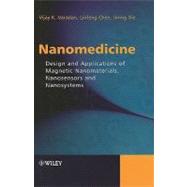
Note: Supplemental materials are not guaranteed with Rental or Used book purchases.
Purchase Benefits
What is included with this book?
Vijay K. Varadan, Department of Electrical Engineering, University of Arkansas, Fayetteville, Arizona, USA
Vijay Varadan is an established Wiley author and is currently a Professor in the Department of Electrical Engineering at the University of Arkansas, USA.? Varadan's new book for Wiley, Smart Material Systems and MEMS, is due to publish later this year, and he has previously co-authored Microwave Electronics (Wiley, 2004), RF MEMS and their Applications (Wiley, 2002), Microsensors, MEMS and Smart Devices (Wiley, 2002) and Microstereolithography and other Fabrication Techniques for 3D MEMS (Wiley, 2001). He is also Editor-in-Chief of the SPIE's Journal of Smart Materials and Structures.
Lin-Feng Chen, Department of Electrical Engineering, University of Arkansas, Fayetteville, Arizona, USA
Lin-Feng Chen is currently a Senior Research Associate in the Department of Electrical Engineering, University of Arkansas, where his research interests include microwave properties of materials, functional electromagnetic materials and microwave communication devices. He has co-authored Microwave Electronics (Wiley, March 2004) with Professor Varadan, and has previously worked as a Research Scientists at the Temasek Laboratories, National University of Singapore.
J. Xie, Department of Electrical Engineering, University of Arkansas, Fayetteville, AR, USA>
J. Abraham, Department of Electrical Engineering, University of Arkansas, Fayetteville, AR, USA.
| Contents | |
| Preface | |
| About the Authors Introduction | |
| What is nanoscience and nanotechnology | |
| Magnets and nanometers: mutual attraction | |
| Typical magnetic nanomaterials | |
| Nanomedicine and magnetic nanomedicine | |
| Typical biomedical applications of functional magnetic nanomaterials | |
| Physical background for the biomedical applications of functional magnetic nanomaterials | |
| Requirements for biomedical applications | |
| Fundamentals of nanomagnetism | |
| Magnetic relaxation of ferrofluids | |
| Magnetorheology of ferrofluids | |
| Manipulation of magnetic Particles in fluids | |
| Interactions between biological nanomaterials and functionalized magnetic nanoParticles | |
| Magnetic nanoParticles | |
| Introduction | |
| Basics of nanomagnetics | |
| Synthesis techniques | |
| Synthesis of magnetic nanoParticles | |
| Bio-inspired magnetic nanoParticles | |
| Functionalization of magnetic nanoParticles | |
| Future prospects | |
| Biomedical applications of magnetic nanoParticles | |
| Introduction | |
| Diagnostic applications | |
| Therapeutic applications | |
| Physiological aspects | |
| Toxic effects | |
| Magnetosomes and their biomedical applications | |
| Introduction | |
| Magnetosome formation | |
| Cultivation of magnetotactic bacteria | |
| Characterization of magnetosomes | |
| Biomedical applications of magnetosomes | |
| Magnetic nanowires and their biomedical applications | |
| Introduction | |
| Magnetism of magnetic nanowires | |
| Template-based synthesis of magnetic nanowires | |
| Characterization of magnetic nanowires | |
| Functionalization of magnetic nanowires | |
| Magnetic nanowires in suspension | |
| Biomedical applications of magnetic nanowires | |
| Magnetic nanotubes and their biomedical applications | |
| Introduction | |
| Magnetism of nanotubes | |
| Multifunctionality of magnetic nanotubes | |
| Synthesis and characterization of magnetic nanotubes | |
| Biomedical applications of magnetic nanotubes | |
| Magnetic biosensors | |
| Introduction | |
| Magnetoresistance-based sensors | |
| Hall effect sensors | |
| Other sensors detecting stray magnetic fields | |
| Sensors detecting magnetic relaxations | |
| Sensors detecting ferrofluid susceptibility | |
| Magnetic biochips: basic principles | |
| Introduction | |
| Biochips based on giant magnetoresistance sensors | |
| Biochips based on spin valve sensors | |
| Biochips based on magnetic tunnel junctions | |
| Fully integrated biochips | |
| Biomedical applications of magnetic biosensors and biochips | |
| Introduction | |
| DNA analysis | |
| Protein analysis and protein biochips | |
| Virus detection and cell analysis | |
| Study of the interactions between biomolecules | |
| Detection of biological warfare agents | |
| Environmental monitoring and cleanup | |
| Outlook | |
| Appendix | |
| Units for magnetic properties | |
| Table of Contents provided by Publisher. All Rights Reserved. |
The New copy of this book will include any supplemental materials advertised. Please check the title of the book to determine if it should include any access cards, study guides, lab manuals, CDs, etc.
The Used, Rental and eBook copies of this book are not guaranteed to include any supplemental materials. Typically, only the book itself is included. This is true even if the title states it includes any access cards, study guides, lab manuals, CDs, etc.